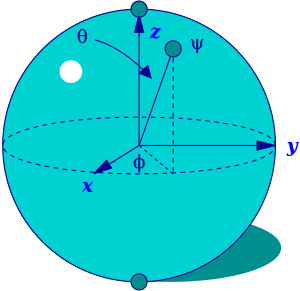كرة بلوخ
في ميكانيكا وحوسبة الكم، كرة بلوخ هي تمثيل هندسي لفضاء حالة بحتة لـ لنظام بميكانيكا الكم ذي مستويين (كيوبت)، وهي مسماة على اسم الفيزيائي فيلكس بلوخ.[1]
Quantum mechanics is mathematically formulated in Hilbert space or projective Hilbert space. The pure states of a quantum system correspond to the one-dimensional subspaces of the corresponding Hilbert space (or the "points" of the projective Hilbert space). For a two-dimensional Hilbert space, the space of all such states is the complex projective line ℂℙ1. This is the Bloch sphere, also known to mathematicians as the Riemann sphere.
كرة بلوخ هي a unit 2-sphere, with antipodal points corresponding to a pair of mutually orthogonal state vectors. The north and south poles of the Bloch sphere are typically chosen to correspond to the standard basis vectors and , respectively, which in turn might correspond e.g. to the spin-up and spin-down states of an electron. This choice is arbitrary, however. The points on the surface of the sphere correspond to the pure states of the system, whereas the interior points correspond to the mixed states.[2][3] The Bloch sphere may be generalized to an n-level quantum system, but then the visualization is less useful.
For historical reasons, in optics the Bloch sphere is also known as the كرة پوانكاريه and specifically represents different types of polarizations. Six common polarization types exist and are called Jones vectors. Indeed Henri Poincaré was the first to suggest the use of this kind of geometrical representation at the end of 19th century,[4] as a three-dimensional representation of Stokes parameters.
The natural metric on the Bloch sphere is the Fubini–Study metric. The mapping from the unit 3-sphere in the two-dimensional state space ℂ2 to the Bloch sphere is the Hopf fibration, with each ray of spinors mapping to one point on the Bloch sphere.
. . . . . . . . . . . . . . . . . . . . . . . . . . . . . . . . . . . . . . . . . . . . . . . . . . . . . . . . . . . . . . . . . . . . . . . . . . . . . . . . . . . . . . . . . . . . . . . . . . . . . . . . . . . . . . . . . . . . . . . . . . . . . . . . . . . . . . . . . . . . . . . . . . . . . . . . . . . . . . . . . . . . . . . .
انظر أيضاً
- Specific implementations of the Bloch sphere are enumerated under the qubit article.
- Atomic electron transition
- Gyrovector space
- Versors
الهامش
- ^ Bloch, Felix (Oct 1946). "Nuclear induction". Phys. Rev. 70 (7–8): 460–474. Bibcode:1946PhRv...70..460B. doi:10.1103/physrev.70.460.
- ^ Nielsen, Michael A.; Chuang, Isaac L. (2004). Quantum Computation and Quantum Information. Cambridge University Press. ISBN 978-0-521-63503-5.
- ^ http://www.quantiki.org/wiki/Bloch_sphere
- ^ Poincaré, Henri (1892). Théorie mathématique de la lumière II. G. Carré.



